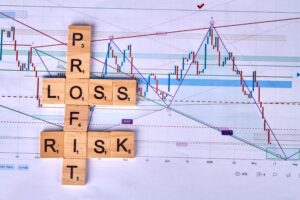In forex trading, one of the key factors that separates successful traders from those who struggle is a solid understanding of the risk-to-reward ratio. This simple yet powerful concept helps you make smarter decisions by comparing the amount you’re willing to risk on a trade with the potential profit you aim to earn. Far too often, new traders focus only on possible gains, overlooking the crucial need to protect their capital. But professional traders know that managing the risk-to-reward ratio is the backbone of a sustainable and profitable trading strategy.
The risk-to-reward ratio acts as your personal decision filter. It tells you whether a trade is actually worth taking, helping you avoid setups where the risks far outweigh the rewards. Whether you’re just getting started or looking to refine your approach in 2025, mastering this concept can transform your trading results. In this article, we’ll break down how the risk-to-reward ratio works, why it matters, and how you can use it to build a trading plan that stands the test of time.
What Exactly Is the Risk-to-Reward Ratio?
The risk-to-reward ratio is a fundamental tool every forex trader should know. It measures how much money you’re willing to risk on a trade compared to the amount of profit you hope to achieve. For instance, let’s say you spot a promising setup and decide to risk $100 with the potential to make $300 in profit. Your risk-to-reward ratio would be 1:3. In simple terms, for every dollar you risk, you’re aiming to earn three dollars. This basic calculation helps you instantly see whether a trade makes sense from a risk management perspective.
Understanding and applying the risk-to-reward ratio is like having a filter for smarter trading decisions. Instead of acting on emotion or gut feelings, you use clear numbers to decide if a trade is truly worth it. The best traders use this ratio to evaluate every trade, setting both their stop-loss and take-profit levels before entering the market.
A strong grasp of the risk-to-reward ratio lets you approach trades with much more confidence and discipline. If you consistently look for trades where the potential reward is at least twice or three times the risk, you put the odds in your favour. Even if you only win half your trades, focusing on a favourable risk-to-reward ratio can keep your account growing over time. This is why mastering this simple metric is such a crucial part of every successful trading plan.u to enter trades more confidently. If you can consistently aim for trades with a high risk-to-reward ratio, you’re more likely to see profits even if you don’t win every single trade.
Why the Risk-to-Reward Ratio is Crucial for Forex Trading
The risk-to-reward ratio isn’t just about numbers—it’s about making smarter decisions as a trader. There are several reasons why this ratio is so important:
- Helps You Manage Risk: When you know how much risk you’re willing to take in each trade, you can avoid emotional decision-making and ensure that you’re staying within your tolerance. It’s like setting limits to protect yourself.
- Keeps You Consistent: A consistent risk-to-reward ratio helps you maintain a steady approach to trading. Even if some trades result in losses, the ones that go well will still help you stay profitable in the long run.
- Reduces Emotional Stress: Having a clear risk-to-reward plan removes the guesswork. When you know exactly where your stop-loss and take-profit levels are, you don’t need to worry about constantly checking the market or making rash decisions.
How to Calculate the Risk-to-Reward Ratio
To calculate the risk-to-reward ratio for any trade, you need to know a few key things:
- Your Entry Point: The price at which you enter the trade.
- Stop-Loss: The price at which you will exit the trade to limit your losses.
- Take-Profit: The price at which you’ll exit the trade to lock in profits.
Let’s say you’re looking to enter a trade at 1.2000, and you decide to set your stop-loss at 1.1950 (50 pips below your entry point). Your take-profit target might be at 1.2100 (100 pips above your entry point).
In this case, your risk-to-reward ratio would be 1:2 because you’re risking 50 pips to make 100 pips.
Stop-Loss and Take-Profit Orders: Crucial Tools for Managing Risk
To manage your risk effectively, stop-loss and take-profit orders are essential. These tools automate the process of exiting a trade when prices move in your favour or against you, which can be a real help when you’re busy or trading across different time zones.
- Stop-Loss Orders: A stop-loss is a level you set at which your trade automatically closes if the price moves against you. It limits your losses and ensures you don’t lose more than you’re willing to risk.
- Take-Profit Orders: Similarly, a take-profit order sets a price level where your trade will close automatically to lock in profits. This is crucial in fast-moving markets, ensuring you don’t miss out on potential profits.
These orders help maintain the risk-to-reward ratio and protect you from emotional decision-making while trading.
Position Sizing in Forex Trading: Managing Your Risk
Position sizing is an essential element of managing the risk-to-reward ratio. It refers to the amount of capital you risk on a single trade. Proper position sizing ensures that even if you lose a trade, the loss won’t be big enough to wipe out your account.
To calculate your position size, take the following steps:
- Decide how much of your capital you’re willing to risk on a trade—commonly, this is 1% or 2% of your total trading capital.
- Determine your stop-loss distance (the number of pips between your entry point and stop-loss).
- Use a position sizing calculator to determine how many units you should trade to stay within your risk tolerance.
By adjusting your position size based on your risk level, you can prevent major losses and protect your account over time.
Common Mistakes When Using the Risk-to-Reward Ratio
Even experienced traders can make mistakes with the risk-to-reward ratio. Here are a few of the most common pitfalls to avoid:
- Setting Unrealistic Reward Targets: One common mistake is to set reward targets that are too high. Aiming for huge profits can often lead to frustration if the market doesn’t meet your expectations. A balanced ratio (e.g., 1:2) is generally more achievable.
- Neglecting Stop-Loss Orders: Some traders avoid setting stop-loss orders because they’re afraid of getting stopped out early. However, this can lead to much larger losses in volatile markets. Always have a stop-loss in place to protect yourself.
- Changing Position Sizes Too Often: While it’s important to adjust your position size based on your account balance, inconsistent sizing can hurt your risk management. Stick to your plan and adjust based on your predefined risk levels.
- Overtrading: Trying to take too many trades can lead to taking on more risk than you should. Stick to your plan and only take trades that align with your risk-to-reward strategy.
A Real-World Example of Risk-to-Reward Ratio
Let’s consider a real-world example of how the risk-to-reward ratio works in practice.
Imagine you’re trading with a $5,000 account and decide to risk 1% on each trade. This means you’re willing to risk $50 per trade. You enter a trade with a stop-loss 50 pips away and set your take-profit at 100 pips. This gives you a 1:2 risk-to-reward ratio.
After 10 trades, you win 4 and lose 6. Let’s see how this would play out:
- The 4 winning trades would give you $200 ($50 per win).
- The 6 losing trades would cost you $300 ($50 per loss).
Even though you lost more trades than you won, your overall profit is still $100 ($200 in wins minus $300 in losses). This is the power of a good risk-to-reward ratio: even when you lose more trades, you can still end up in the green as long as your rewards are bigger than your risks.
Final Thoughts
In the world of forex trading, understanding the risk-to-reward ratio is essential for long-term success. By setting clear stop-loss and take-profit orders, managing your position size, and avoiding common mistakes, you can make smarter trades and reduce unnecessary risks.
While no trader can avoid losses entirely, maintaining a favourable risk-to-reward ratio helps you minimise the impact of losses and increase the likelihood of turning a profit. With time, consistency, and a solid understanding of risk management, you’ll be able to navigate the forex market more confidently and efficiently.
Read here to learn more about “Paper Trading: The Safe Way to Learn Trading in 2025“.

I’m Chaitali Sethi — a seasoned financial writer and strategist specializing in Forex trading, market behavior, and trader psychology. With a deep understanding of global markets and economic trends, I simplify complex financial concepts into clear, actionable insights that empower traders at every level. Whether it’s dissecting winning strategies, breaking down market sentiment, or helping traders build the right mindset, my content bridges the gap between information and implementation.

